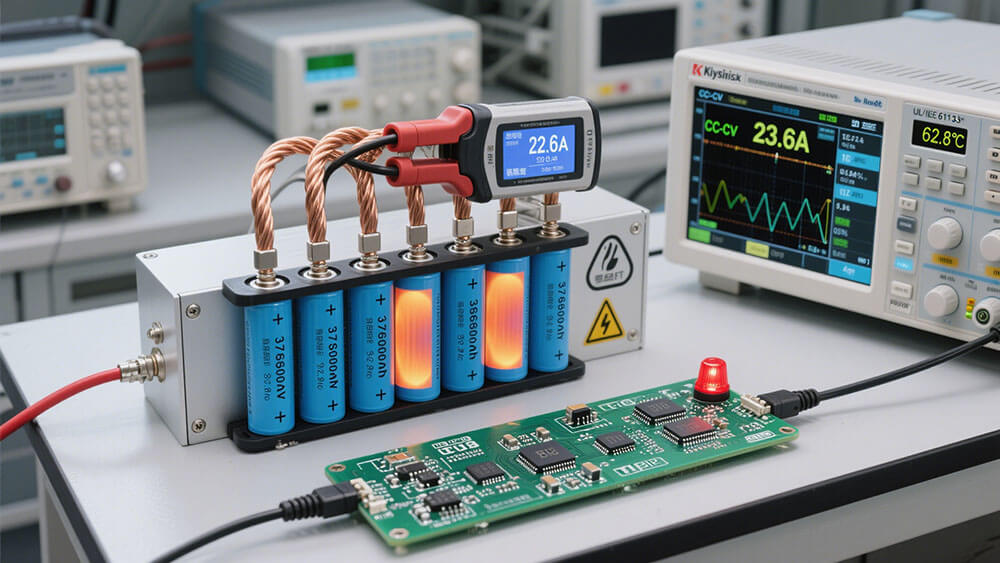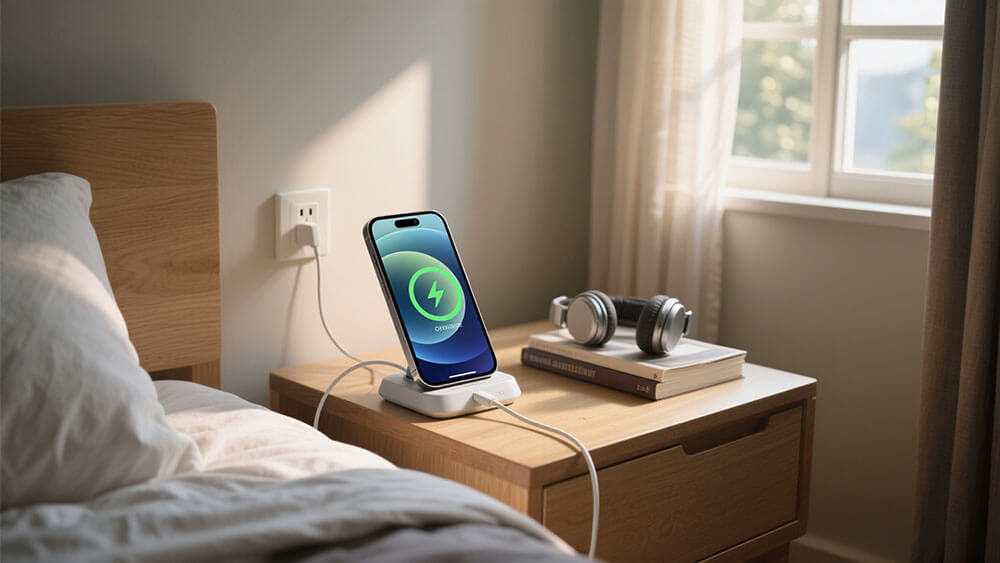Contents

Proper parallel battery charging is crucial for maintaining the safety and efficiency of lithium battery packs. By charging batteries in parallel, you can significantly boost their capacity and extend their runtime. However, improper handling can lead to risks like overheating, imbalance, or even safety hazards. Always prioritize safe charging practices.
Key Takeaways
Make sure batteries have the same voltage and capacity before connecting. This avoids overheating and keeps them balanced.
Use a Battery Management System (BMS) to check voltage and heat. It keeps charging safe and makes batteries last longer.
Look for overheating or imbalance while charging. Fix problems quickly to stay safe.
Part 1: Understanding Parallel Battery Charging

1.1 What Is Parallel Battery Charging?
Parallel battery charging refers to the process of charging multiple batteries connected in parallel. In this configuration, the positive terminals of all batteries connect to one another, as do the negative terminals. This setup increases the total capacity of the battery system while maintaining the same voltage. For example, if you connect two 12V batteries with 50Ah each in parallel, the system will still operate at 12V but with a combined capacity of 100Ah.
This charging method is particularly useful for applications requiring extended runtime without altering voltage, such as in RVs, boats, and renewable energy systems. By using a single battery charger, you can charge all batteries simultaneously, improving charging efficiency and simplifying the process.
Tip: Always ensure the batteries connected in parallel have similar capacities and charge levels to avoid imbalance issues.
1.2 Importance of Charging Batteries in Parallel
Charging batteries in parallel offers several advantages. First, it amplifies the total capacity, allowing your system to store more energy and run longer. Second, it maintains consistent system voltage, which is critical for devices designed to operate at specific voltage levels. Third, it provides scalability, enabling you to add more batteries as your energy needs grow.
Key Benefits:
Amplified Total Capacity: Extends runtime by summing individual battery capacities.
Consistent Voltage: Ensures compatibility with voltage-sensitive systems.
Scalability: Easily expand your system without major modifications.
Cost Efficiency: Modular upgrades reduce replacement costs.
A study by Battery Council International highlights that parallel battery systems can last 15–20% longer than single-battery setups under similar conditions. This makes charging batteries in parallel a practical choice for both residential and commercial applications.
1.3 Key Considerations for Lithium Battery Packs
When charging lithium battery packs in parallel, safety and proper management are paramount. Lithium batteries are sensitive to overcharging, overheating, and imbalance, which can lead to performance issues or safety hazards. To ensure proper parallel battery charging, follow these guidelines:
Use Matching Batteries: Ensure all batteries have the same voltage, capacity, and state of charge.
Incorporate Safety Features: Use fuses, monitoring circuits, and quality charging cables to prevent overheating and short circuits.
Monitor the Charging Process: Regularly check for signs of imbalance or overheating during charging.
Adhere to Testing Standards: Lithium batteries undergo rigorous tests, such as thermal stability and short-circuit resistance, to ensure safety.
Safety Tips: Always use a battery charger designed for lithium batteries and avoid charging two batteries in parallel if they differ significantly in capacity or charge level.
Part 2: Risks and Challenges in Charging Batteries in Parallel

2.1 Common Risks in Parallel Battery Charging
Charging batteries in parallel comes with inherent risks that require your attention. One of the most critical dangers is thermal runaway, where excessive heat causes a chain reaction, potentially leading to fires or explosions. Lithium batteries, when burning, release oxygen, making fire suppression more challenging. Rapid charging or improper connections can exacerbate this issue.
To mitigate these risks, always charge in a fireproof location and keep a fire extinguisher nearby. Avoid connecting batteries with mismatched cell counts or voltage levels, as this can result in dangerous current surges. Fire departments in cities like New York and San Francisco have reported over 660 lithium-ion battery fire incidents since 2019, with 12 fatalities and 260 injuries in New York City alone from 2021 to early 2023. These statistics highlight the importance of proper parallel battery charging practices.
2.2 Uneven Battery Capacities in Parallel Battery Charging
Uneven battery capacities in a parallel configuration can lead to significant performance issues. When batteries connected in parallel have different capacities or charge levels, the stronger battery may overcompensate for the weaker one. This imbalance can cause overheating, reduced efficiency, and accelerated degradation of the battery pack.
Studies, such as those by Gogoana et al. (2014) and An et al. (2021), emphasize the importance of matching internal resistance and minimizing cell-to-cell variations. For example, a battery pack reaches its “End of Life” when its discharge capacity drops to 80% of its nominal capacity. Ensuring uniformity among batteries helps maintain their longevity and performance.
2.3 Preventing Imbalance in Parallel Battery Charging
Preventing imbalance during parallel battery charging requires careful preparation and monitoring. Start by using a battery charger designed for lithium batteries. Ensure all batteries have the same voltage, capacity, and state of charge before connecting them. This minimizes the risk of uneven current distribution.
Regularly monitor the charging process for signs of overheating or imbalance. Incorporate safety tips like using fuses and monitoring circuits to protect against short circuits. Charge in a fireproof area and keep a fire extinguisher nearby for added safety. By following these steps, you can ensure proper parallel battery charging and extend the lifespan of your battery pack.
Part 3: Step-by-Step Guide to Proper Parallel Battery Charging

3.1 Tools and Equipment for Parallel Battery Charging
Before you begin charging batteries in parallel, gather the necessary tools and equipment to ensure a safe and efficient process. Using the right tools minimizes risks and helps maintain the longevity of your lithium batteries. Here’s what you’ll need:
Battery Charger: Select a charger specifically designed for lithium batteries and capable of handling parallel configurations. Ensure it matches the voltage and capacity of your battery pack.
High-Quality Cables: Use cables rated for the total current of your setup. Poor-quality cables can overheat and pose safety risks.
Battery Management System (BMS): A BMS monitors voltage, current, and temperature, ensuring safe operation and preventing imbalances.
Multimeter: This tool helps you measure voltage and confirm that all batteries are at similar charge levels before connecting them.
Safety Gear: Wear insulated gloves and safety goggles to protect yourself from accidental sparks or short circuits.
Tip: Always inspect your tools and equipment for damage before use. Faulty tools can compromise the charging process and lead to safety hazards.
3.2 Preparing Lithium Batteries for Parallel Charging
Proper preparation is crucial for charging safely and avoiding issues like overheating or imbalance. Follow these steps to get your batteries ready:
Match Battery Specifications: Ensure all batteries have the same voltage, capacity, and state of charge. Mismatched batteries can lead to uneven current distribution.
Inspect the Batteries: Check for physical damage, leakage, or swelling. Damaged batteries should not be used in a parallel setup.
Verify Compatibility: Confirm that your battery charger is compatible with lithium batteries and supports parallel charging.
Install a BMS: A Battery Management System ensures even charging and discharging, preventing safety risks and extending battery life.
Test Voltage Levels: Use a multimeter to measure the voltage of each battery. All batteries should have similar voltage levels before connecting them.
Safety Consideration: Never attempt to charge batteries with significant differences in voltage or capacity. This can cause overheating and reduce the lifespan of your battery pack.
3.3 Safe Connection of Batteries in Parallel
Connecting batteries in parallel requires precision and attention to detail. Improper connections can lead to short circuits or imbalances. Follow these steps to connect your batteries safely:
Arrange the Batteries: Place the batteries on a non-conductive surface in a well-ventilated area.
Connect Positive Terminals: Use a high-quality cable to connect the positive terminals of all batteries.
Connect Negative Terminals: Similarly, connect the negative terminals of all batteries using another cable.
Secure the Connections: Ensure all connections are tight and secure to prevent loose wires or sparks.
Attach the Charger: Connect the charger to the positive and negative terminals of the parallel setup.
Note: Always double-check your connections before turning on the charger. Incorrect wiring can damage your batteries and pose safety risks.
3.4 Monitoring and Managing the Charging Process
Once the charging process begins, active monitoring is essential to ensure everything runs smoothly. Here’s how you can manage the process effectively:
Use a BMS: A Battery Management System monitors voltage, current, and temperature, preventing overcharging and imbalance.
Check Charge Levels: Regularly measure the voltage of each battery using a multimeter to ensure even charging.
Watch for Overheating: Feel the batteries periodically to check for excessive heat. Overheating indicates a problem that needs immediate attention.
Maintain Ventilation: Ensure the charging area is well-ventilated to dissipate heat and prevent the buildup of flammable gases.
Supervise the Process: Never leave the batteries unattended while charging. Continuous supervision helps you respond quickly to any issues.
Tip: If you notice any unusual behavior, such as swelling or excessive heat, stop the charging process immediately and inspect the setup.
3.5 Safely Disconnecting Batteries After Charging
Once the batteries are fully charged, disconnecting them safely is just as important as the charging process. Follow these steps to avoid accidents:
Turn Off the Charger: Always switch off the charger before disconnecting any cables.
Disconnect the Charger: Remove the charger cables from the battery terminals, starting with the negative terminal.
Separate the Batteries: Disconnect the cables linking the batteries in parallel, ensuring no sparks occur.
Inspect the Batteries: Check for any signs of overheating or damage before storing or using the batteries.
Store Safely: Place the batteries in a cool, dry location away from flammable materials.
Safety Tip: Always handle batteries with care and avoid touching the terminals directly. Use insulated tools to prevent accidental short circuits.
Part 4: Troubleshooting Issues in Parallel Battery Charging

4.1 Identifying and Resolving Imbalance Problems
Imbalance in parallel battery charging can lead to uneven current distribution, reduced efficiency, and accelerated wear. To identify and resolve these issues, you can rely on diagnostic techniques that measure key battery parameters.
Open Circuit Voltage (OCV): This method estimates the state of charge (SOC) after the battery stabilizes. It provides accurate results but requires time for the battery to reach equilibrium.
Electromotive Force (EMF): Another SOC estimation technique, useful for identifying discrepancies between batteries.
Model-Based Approaches: Advanced methods like Kalman filters or machine learning algorithms offer high precision but may require significant computational resources.
For practical application, consider these steps:
Use the OCV method for precise SOC estimation, especially when time permits.
Apply the internal resistance method to detect imbalances, though it may face challenges across a wide SOC range.
Employ Coulomb counting if the initial SOC is known, ensuring your sensors have adequate resolution.
Tip: Regularly monitor SOC levels and internal resistance to catch imbalances early. This proactive approach extends battery life and improves performance.
4.2 Addressing Overheating During Charging
Overheating is a critical issue that can compromise safety and battery longevity. It often results from excessive current flow, poor ventilation, or imbalances in the battery pack. To address this, you should focus on both prevention and active monitoring.
Ensure the charging area is well-ventilated to dissipate heat effectively.
Use a Battery Management System (BMS) to monitor temperature and prevent thermal runaway.
Regularly inspect connections and cables for wear or damage that could cause localized heating.
If overheating occurs, stop the charging process immediately. Allow the batteries to cool in a safe, non-flammable area. Investigate the root cause before resuming charging.
Safety Note: Never attempt to charge a battery that shows signs of swelling or leakage. These are indicators of internal damage and potential failure.
4.3 Solutions for Charging Failures or Inconsistencies
Charging failures or inconsistencies in parallel configurations often stem from diagnostic limitations or system-level challenges. Addressing these issues requires a combination of advanced tools and thorough analysis.
Key Insights | Description |
|---|---|
Diagnostic Technology | Extending single-cell diagnostics to multicell setups remains a challenge. |
Fault Case Studies | Examples include lithium plating and SOC imbalance in parallel systems. |
Challenges | Adapting diagnostics for larger systems introduces additional complexity. |
Thermal gradients also play a significant role in charging inconsistencies. They can cause uneven current distribution and SOC imbalances, leading to divergent degradation modes. Monitoring cathode impedance growth, which correlates with temperature, helps identify these issues early.
Pro Tip: Use diagnostic tools designed for multicell configurations to detect and resolve faults effectively. This ensures consistent performance and minimizes long-term degradation.
Charging lithium batteries in parallel demands precision and adherence to safety protocols. You should follow key steps, including matching battery specifications, using a Battery Management System (BMS), and actively monitoring the charging process. Proper tools and equipment, such as lithium-specific chargers, ensure efficiency and safety.
Tip: Explore Large Power‘s custom battery solutions for tailored lithium battery packs that meet your unique requirements.
Adopting best practices not only extends battery life but also minimizes risks like overheating or imbalance. By prioritizing safety and efficiency, you can optimize your lithium battery system for industrial, medical, or consumer electronics applications.
FAQ
1. What happens if I connect batteries with different capacities in parallel?
Connecting batteries with different capacities can cause imbalance. The stronger battery compensates for the weaker one, leading to overheating, reduced efficiency, and faster degradation.
Tip: Always match battery capacities to avoid performance issues.
2. Can I use any charger for lithium batteries in parallel?
No, you must use a charger designed for lithium batteries. Generic chargers may cause overcharging or overheating, compromising safety and battery lifespan.
3. How do I know if my batteries are overheating during charging?
Feel the batteries periodically. If they feel excessively hot, stop charging immediately. Overheating indicates a problem that requires inspection before resuming the process.
Safety Note: Never charge a battery showing signs of swelling or leakage.
Tip: Explore Large Power‘s custom battery solutions for tailored lithium battery packs that meet your unique requirements.





